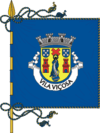Vila Viçosa
| Vila Viçosa | |||
|---|---|---|---|
| Municipality | |||
| |||
 | |||
| Coordinates: 38°46′N 7°25′W / 38.767°N 7.417°WCoordinates: 38°46′N 7°25′W / 38.767°N 7.417°W | |||
| Country |
| ||
| Region | Alentejo | ||
| Subregion | Alentejo Central | ||
| Intermunic. comm. | Alentejo Central | ||
| District | Évora | ||
| Parishes | 4 | ||
| Government | |||
| • President | Luís Caldeirinha (SP) | ||
| Area | |||
| • Total | 194.86 km2 (75.24 sq mi) | ||
| Population (2011) | |||
| • Total | 8,319 | ||
| • Density | 43/km2 (110/sq mi) | ||
| Time zone | WET/WEST (UTC+0/+1) | ||
| Website | http://www.cm-vilavicosa.pt | ||
Vila Viçosa (Portuguese pronunciation: [ˈvilɐ viˈsɔzɐ]) is a municipality in the District of Évora in Portugal. The population in 2011 was 8,319,[1] in an area of 194.86 km².[2]
The present Mayor is Luís Caldeirinha, elected by the [Socialist Party]. The municipal holiday is August 16.
Parishes
Administratively, the municipality is divided into 4 civil parishes (freguesias):[3]
- Bencatel
- Ciladas
- Nossa Senhora da Conceição e São Bartolomeu
- Pardais
History
The area of Vila Viçosa has been inhabited since Antiquity, and it was the site of a small settlement in Roman times. The region was part of the Visigoth Kingdom and in the eighth century came under Moorish control after the Muslim conquest of Hispania. Moorish domination ended in 1217, when the region was reconquered by the Order of Aviz, a military order of knighthood that reclaimed large parts of Southern Portugal to the Christians. The order promoted the settlement of Christians in the area during the 13th century. In 1270, King Afonso III granted a foral(letter of feudal rights) to the incipient village of Vila Viçosa. In the early 14th century, King Dinis I built a castle in the village, to protect it from potential Castilian incursions.
In 1461, Vila Viçosa came to the hands of the House of Braganza, one of the most important houses of nobility of Portugal. This event was crucial in the history of the village, which became the main base of the Dukes of Braganza in the next centuries. The Dukes had considerable wealth and greatly promoted the economic, urban and artistic development of the village.
In 1502 the building of the Ducal Palace of Vila Viçosa was begun, sponsored by Jaime, fourth Duke of Braganza. Jaime was a skilled military leader who later led the Portuguese to victory against a Moorish army in the Battle of Azamor, in Morocco. The Ducal Palace was greatly remodelled between the 16th and 17th centuries in a sober late Renaissance (Mannerist) style, and was decorated through the centuries by several artists. The Dukes also sponsored artistic campaigns in several churches and monasteries in the village.
When Duke John became King John IV, in 1640, the House of Braganza moved to the capital Lisbon, and many of the riches of the Ducal Palace were transferred to the Ribeira Palace. Vila Viçosa became a vacation spot for the members of the Braganza family. This marks the beginning of a period of decay for Vila Viçosa.
Economy
In the 20th century the industries of marble extraction and tourism became the main income sources of the municipality. Agricultural goods are also still important for its economy. Marble extraction and processing are responsible for around 93% of jobs in the municipality. Since the early 2000s,the displacement of material production outside Europe and the decreasing demand for natural stone have weakened local marble industries, starting an inexorable process of urban shrinking and depopulation.
Population
| Population of Vila Viçosa municipality (1801 – 2011) | ||||||||
|---|---|---|---|---|---|---|---|---|
| 1801 | 1849 | 1900 | 1930 | 1960 | 1981 | 1991 | 2001 | 2011 |
| 5697 | 5821 | 7163 | 8444 | 9974 | 8546 | 9068 | 8871 | 8319 |
Notable citizens
- Martim Afonso de Sousa, 16th-century Portuguese explorer.
- King John IV of Portugal, first king of the House of Braganza.
- Catherine of Braganza, Queen of England in the 17th century.
- Henrique Pousão, 19th-century painter.
- Florbela Espanca, notable, early 20th-century poet.
- Bento de Jesus Caraça, mathematician and economist.
 The local castle and town below.
The local castle and town below. Town square.
Town square.
References
- ↑ Instituto Nacional de Estatística
- ↑ Direção-Geral do Território
- ↑ Diário da República. "Law nr. 11-A/2013, page 552 139" (pdf) (in Portuguese). Retrieved 5 August 2014.
External links
 Media related to Vila Viçosa at Wikimedia Commons
Media related to Vila Viçosa at Wikimedia Commons- Town Hall official website


